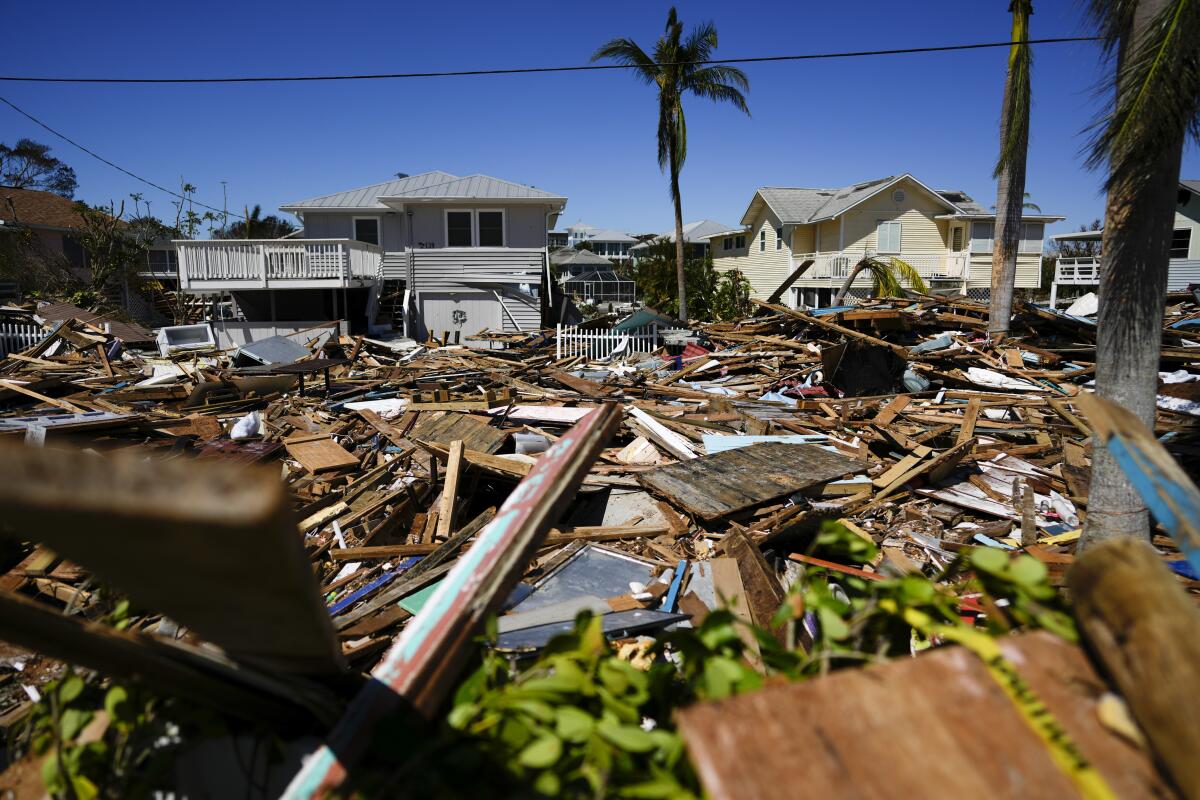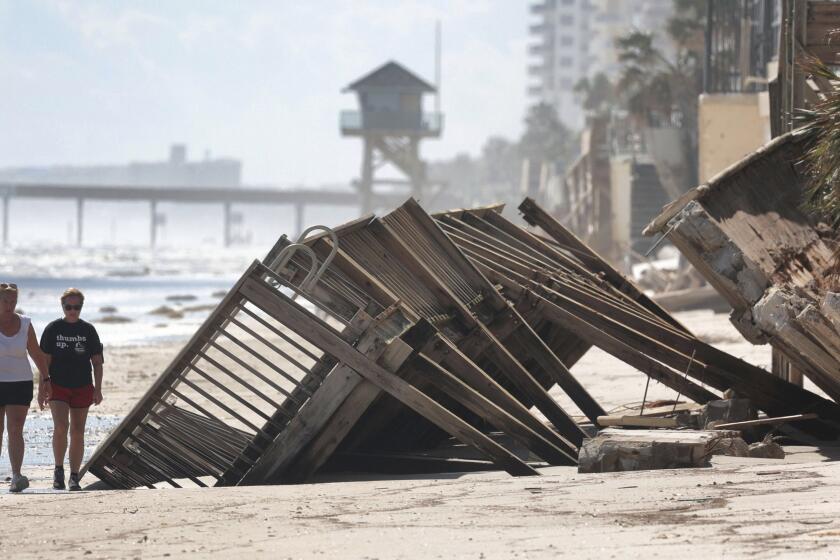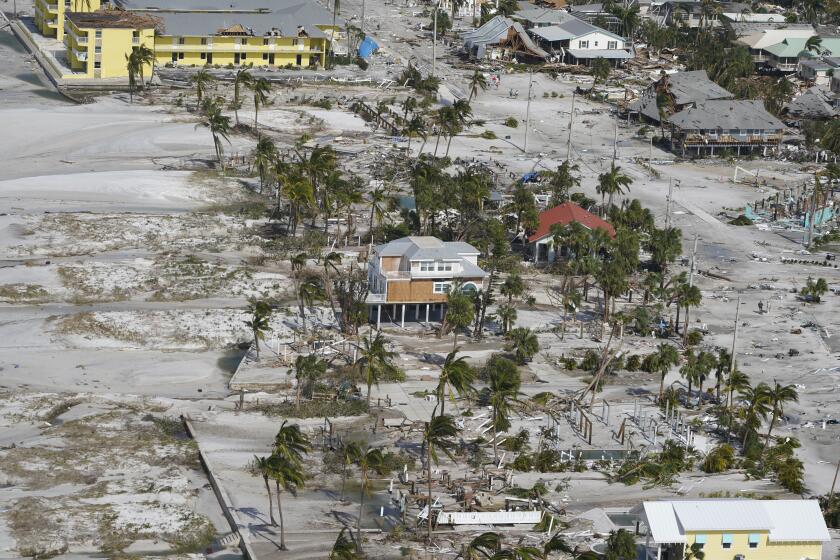Op-Ed: Hurricane Ian and the coming climate crash

- Share via
Florida Gov. Ron de Santis called Hurricane Ian a “once in 500-year event.”
If only. Floridians could then rebuild after Ian and return to business as usual.
Unfortunately, because of climate change, past weather patterns are becoming less and less useful for pricing future weather-related risks. Rather than 500-year events, biblical floods have become near annual events in the U.S.
Ian is the poster child of how recent hurricanes have been affected by climate change: rapid intensification, astounding rains related to very slow speed over land and extremely high wind speeds related to the energy supplied by the warming oceans. Rather than an anomaly, Ian shows us what happens when a society underprices climate risk.
As the frequency and intensity of economically destructive events such as storms, floods, fires, droughts and extreme temperatures increase, the risk rises of a climate-related repeat of the crash of 2008, with the difference being that the economic destruction will only increase in subsequent years.
Days after Hurricane Ian carved a path of destruction from Florida to the Carolinas, the dangers persisted, and even worsened in some places.
With Ian, the most dramatic underestimation of risk took place in the central part of Florida. The hurricane crossed the state at the speed of a recreational jogger (the slowing speed of hurricanes relates to a loss of vigor in the steering winds, which in turn relates to the warming of the Arctic), a pace that led to astounding rainfall — 28.6 inches in one spot.
Estimates of insured losses from the storm run to $63 billion, but it’s the uninsured losses that will wreak economic havoc. For instance, the risk analysis company Verisk estimates inland Florida’s insured losses from flooding to be about $1 billion. Sounds modest, but the number is so low because very few homeowners in central Florida have flood insurance. In Orlando the figure is 1.5%, suggesting that the losses that will be borne by homeowners and businesses in central Florida will run into the tens of billions.
Climate risk for those closer to the coast has also been underpriced for decades. After private insurers began pulling out of the state following a drumbeat of weather-related losses, Florida set up the Citizens Property Insurance Corp., as a backstop. It quickly became the largest insurer in the state, which is evidence that it underprices wind risk. Similarly, coastal flood risk from storms and sea level rise is backstopped — and underpriced — by U.S. taxpayers through the National Flood Insurance Program under the Federal Emergency Management Agency. NFIP is now more than $20 billion in debt despite having $16 billion in debt canceled by Congress as recently as 2017.
One result of underpricing risks is a flood of people moving to dangerous areas. According to census data, Lee County, home to Ian-devastated Fort Myers, has seen a 50% population increase since it was hit by Hurricane Charley in 2004; Miami Dade County has grown by 600,000 people since Hurricane Andrew did over $50 billion in damage there in 1992. In California, millions of people have moved into fire-prone zones since a megadrought began at the turn of the millennium.
Once upon a time, I expected the insurance industry would be the White Knight of climate change, simply because the industry relies on the proper estimation of risk. I underestimated the power of business as usual and the industry’s genius at off-loading risk.
Climate change isn’t just one of many issues readers are discussing after Hurricane Ian. It’s what’s driving their discussion.
After Hurricane Andrew, for instance, the reinsurance industry began selling catastrophe bonds — so-called cat bonds — securities that paid a high interest rate for insuring a specific risk for a limited time period. (Ian threatens this market, as the storm will visit huge losses on cat bonds tied to named storms hitting Florida.) Moreover, most property insurance policies are renewable on a yearly basis, which gives private insurers the option of raising rates or pulling out of a market.
Finally , after years of record losses tied to weather and climate, insurers are beginning to act as they should have done long ago. After a succession of record-breaking fires in the West, insurers have stopped offering policies in the most vulnerable areas. California has slowed this exodus by imposing a moratorium on insurance cancellation for ZIP Codes covered by fire-related emergency declarations. Nonetheless, major insurers such as AIG have pulled out of the state, leaving homeowners with skyrocketing rates in the private market or fire insurance from a bare-bones backstop supplied by the state.
So long as the burden of greenhouse gases in the atmosphere continues to increase, the already identified climate risks to the economy will continue to increase, new unanticipated risks will emerge and the cost of insuring those risks will rise, perhaps rapidly to catch up with decades of underpricing. At some point, rates will become unaffordable for the average American in an expanding number of counties vulnerable to one or several climate-related risks, and/or the taxpayers will rebel against paying for those risks for those who persist in living in harm’s way.
The multi-trillion dollar question looming over our future is whether the nation can begin an orderly adjustment to this new reality, or whether that adjustment will be forced as the result of a housing crash and economic crisis.
Eugene Linden is the author, most recently, of “Fire and Flood: A People’s History of Climate Change, from 1979 to the Present.”
More to Read
A cure for the common opinion
Get thought-provoking perspectives with our weekly newsletter.
You may occasionally receive promotional content from the Los Angeles Times.












